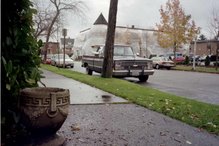Murray
Ryerson, a supportive character in the V.I. Warshawski series, is an
investigative reporter. Digital change has
reduced his prestige and his control over his content. Alternative truth floods the airwaves from a
source that was reliable print reporting and editorial content. I wish to share a paragraph:
I found a
meter around the corner from the Star's building on Kinzie and Canal. One of Global's economizing measures had been
to close down the Star's beaux arts building in the Loop and to move the
reporting and editorial staff out to the press building along the Chicago
River. Given the four-hundred-million-dollar
price tag for Global's corporate headquarters on Wacker, I suppose every penny
saved on investigative journalism was essential; through my haze of anger I
felt a brief twinge of sympathy for Murray, moved into this dingy building in
the shadow of the rail yards and expressways.
The
central character's series of interviews that begins with Murray Ryerson in his
cubical (and does continue to Global's high rise new office) contrasts with an
earlier scene at the apartment of the title (Breakdown) character. In the
disarray from Leydon Ashford's Bipolar illness, V.I. clears plates of food from
rooms, clears perishables from the refrigerator, does the dishes, while she
searches for clues. Leydon was a college
classmate who during a Bipolar relaspse fell from a balcony in a chapel.
Breakdown begins
with an alternative truth: V.I.
Warshawski's search for thirteen-year-olds who are out after curfew progresses
to their shared discovery of a dead body.
Before V.I. will connect with the police, she starts the group of girls away
from the scene so that the police will not interview them until their parents
are present.
I am sure we share her
belief that a separate truth in this way is appropriate, it is appropriate to
show children a different emphasis because only years of time can allow them
perspective on topics adults have to manage.


No comments:
Post a Comment